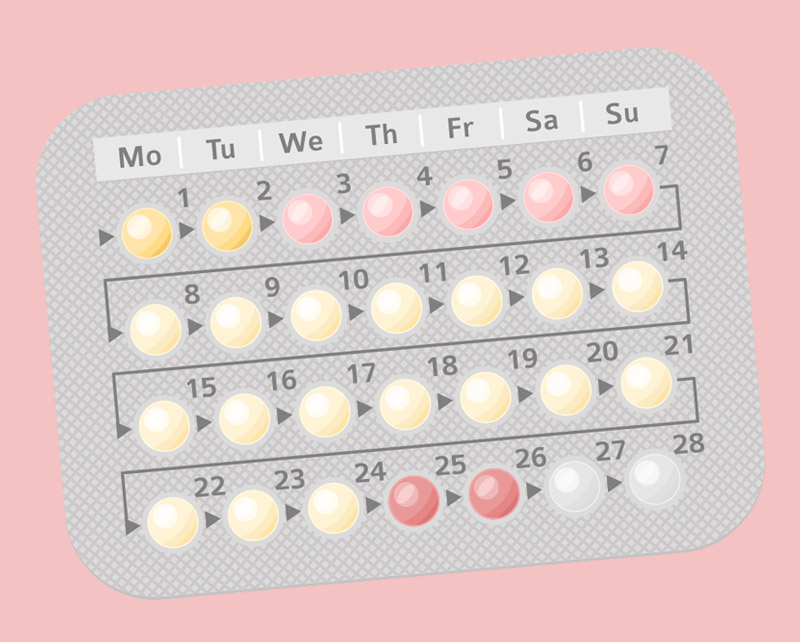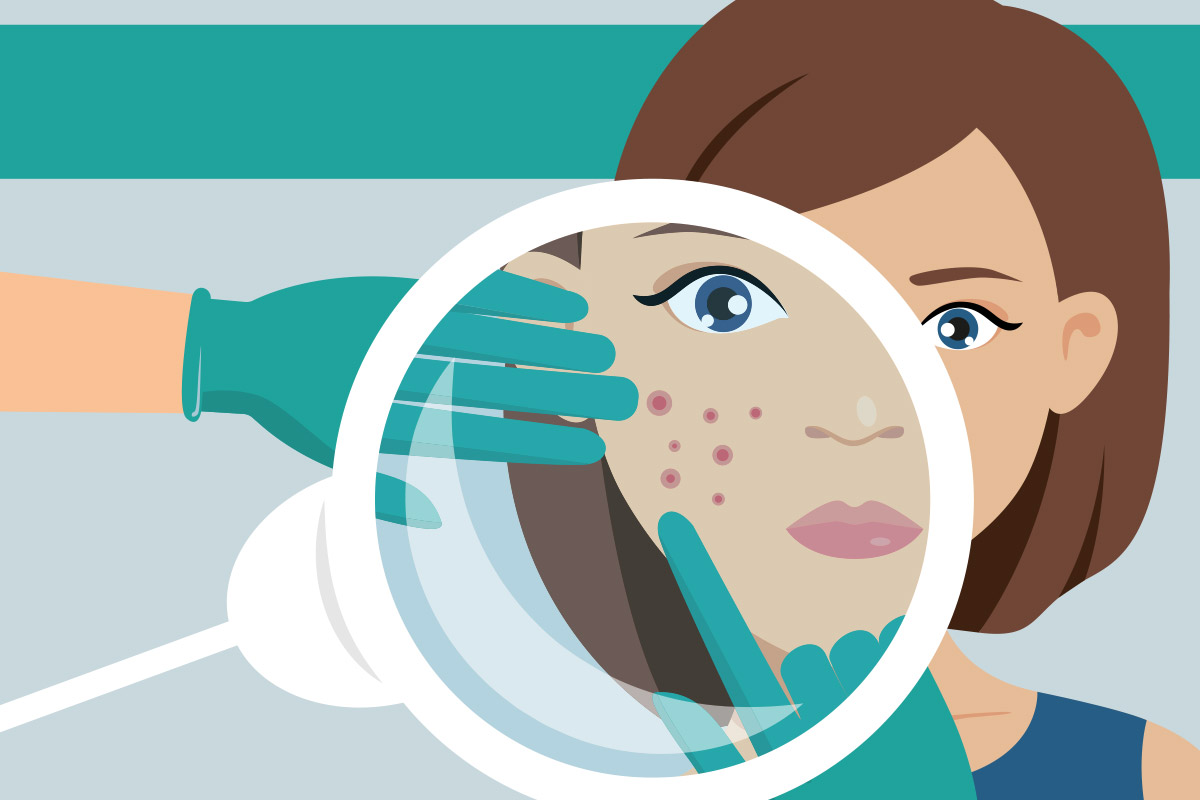Home » Acne Treatments » Acne Medication » Hormonal Treatments For Acne
Hormonal Treatments For Acne
Hormonal acne treatments can be highly effective
They’re often used to treat other conditions, but hormonal treatments for acne are prescription medications which have also been shown to help improve some types of acne.
For example, some types of contraceptive (birth control) pills and even a type of blood pressure medication are hormonal treatment options that a doctor may consider to help manage your acne.
Another type of hormonal treatment – oral corticosteroids – may be recommended as a short-term measure if you have severe acne. This is sometimes used to calm acne flare ups when you’re starting a longer term medical treatment like isotretinoin (e.g. Oratane, Roaccutane) or if a rapid improvement in your skin is needed.
Looking to clear up back acne? Find out how.
Using the contraceptive pill for acne
Many people think about ‘the pill’ as a contraceptive (to prevent pregnancy) but it can also help some women to control their acne.
Several contraceptive pills contain a combination of synthetic forms of the female hormones oestrogen and progesterone.
These combination pills can help to treat acne by improving and ultimately blocking the effect that androgens (male hormones) have on the skin.
If you’re aged 25 or over have adult acne and/or if you experience acne flare-ups right before your period, the pill may be particularly useful.

Types of birth control pills for managing acne
There is a range of combined oral contraceptive pills you and your doctor can consider to help manage your acne.
We’ve provided information on some regularly used and recommended combinations that your doctor may prescribe, depending on your specific situation.
Generally, you can expect to see acne improvements within three months of starting contraceptive type hormonal treatments, with the full effect usually seen within about six months.
If this doesn’t happen, your doctor might consider a change in medication dose or introduce another therapy to help improve your results.
Very low dose pills
Low oestrogen dose pills containing 20mcg ethinyloestradiol along with the following progesterones are acne treatment options:
- Low dose levonorgestrel (100mcg), such as Femme-Tab ED 20/100, Loette and Microlevlen ED (pills containing higher doses of levonorgestrel, e.g. 150mcg have been shown to be less useful and in some cases, worsen acne). Note: Femme-Tab ED is listed on the Pharmaceutical Benefits Scheme for contraceptive use.
- Drospirenone (3mg) – such as Yaz and Yaz Flex
Low dose pills
These pills contain more oestrogen (30mcg) along with the following progesterones:
- Dienogest (2mg) such as Valette. This type of pill has also been shown to be of particular benefit for women with hormonal imbalances related to PCOS and menstrual irregularities
- Drospirenone (3mg) – such as Isabelle, Petibelle and Yasmin
- Norethindrone acetate (1mg) – none currently listed in Australia
Other oral contraceptive pills
Combined oral contraceptive pills contain higher oestrogen (35mcg ethyloestradiol) and another progesterone/anti-androgen cyproterone acetate (2mg). These include Brenda-35 ED, Estelle-35 ED, Diane-35 ED, Juliet-35 ED.
Other contraceptive pills that have been shown to improve acne include those containing the progestogens gestodene (such as Minulet). Results for this combination are limited.
Implantable contraceptive devices such as Implanon and Mirena are likely to cause a flare of your acne because of their active ingredients (etonogestrel in Implanon; levonorgestrel in Mirena).
If this is the best contraceptive for you, you may need to consider other acne treatment options.
Potential side effects of the pill
Generally, there are fewer side effects with lower dose pills and these still provide good contraceptive protection. However, it’s important to remember that you need to take very low dose pills about the same time every day.
If your primary goal for taking the pill is to prevent pregnancy, there’s evidence to show an improved benefit of contraception in higher oestrogen containing pills. These higher dose pills should still be taken daily but with less emphasis on regular dose-timing.
Breakthrough bleeding is a more common problem if you’re taking a very low dose pill compared to taking one with a higher dose of oestrogen. Pills containing higher oestrogen are also more likely to be associated with nausea, breast tenderness, bloating and headaches.
Pills containing drospirenone have been shown to have a higher risk of venous thromboembolism/DVT in retrospective studies. Recent prospective studies have challenged the evidence but at this stage, we believe there is insufficient evidence to support this and therefore the risk remains.
Pills containing dienogest have a higher risk for causing mood changes, depression, weight gain and changes in libido. They also carry a higher risk of developing venous thromboembolism/DVT.
For both drospirenone and dienogest, the risk of venous thromboembolism/DVT is increased further if you are a smoker and/or have a BMI >30 (obese, not just overweight).
There are complete details of the known side effects relevant to your pill in the consumer product information. You can find these online by searching for “CMI” or “consumer product information” along with the brand name of your pill.
You can also talk to your doctor for more complete information.
Reduce the risks
The general principle of medication applies – the smallest dose of medication should be used to achieve the desired effect without causing harm.
You can usually reduce the side effects associated with taking the pill by choosing the lowest dose option that will help you improve your acne.
However, in many cases, particularly for moderate or severe acne, you’ll need higher doses of medication to achieve good results.
If the side effects outweigh your treatment goal, you should speak with your doctor immediately to seek alternatives.
Likewise, because contraception is often the main goal of taking the pill, it’s important to take it as directed. Very low dose pills must be taken at around the same time every day to reduce the chance of falling pregnant.
Non-contraceptive hormonal treatments
Spironolactone
Spironolactone is a medication that lowers blood pressure and reduces fluid retention seen in conditions like heart failure and liver disease.
However, it’s also a weak anti-androgen. This means it decreases overall testosterone production and competes with the remaining testosterone and other androgens – stopping them from binding and acting on the skin.
Some studies suggest it may also increase the production of a key binding molecule made in the liver (SHBG), which decreases the action of testosterone circulating in the blood.
Effective doses range from 50-200mg. Spironolactone may be particularly useful for females with excessive body hair (hirsutism) or female pattern alopecia (hair loss).
Spironolactone can often be used to treat acne either on its own or in combination with another therapy, particularly the combined oral contraceptive pill.
You can usually expect to see an improvement in your acne within 2-3 months of starting spironolactone.
Your doctor might need to consider a change in medication dose or introduce another therapy to help improve your results.
Potential side effects of spironolactone
Spironolactone is a diuretic, which means it interferes with the re-absorption of water in the kidneys.
While not all women will notice the effects of this, your doctor will carefully consider your individual circumstances.
Spironolactone should be carefully considered if you’re taking NSAID (non-steroidal, anti-inflammatory) medication such as ibuprofen or certain blood pressure medications (ACEi and ARBs). If possible, these medications should not be taken together.
Reduce the risks
You can usually reduce side effects from spironolactone by starting at a low dose and carefully increasing the dose until you start to see results. However, if you have moderate or severe acne, you may need higher doses of medication to see a significant improvement in your acne.
If side effects outweigh your treatment goal you should speak with your doctor immediately to seek alternatives.
If appropriate, your doctor may consider oral contraception, which may have an additional effect in treating your acne. If you can’t take the pill, have a discussion with your doctor about other contraceptive options.
Maintaining a well-balanced diet and drinking plenty of water when taking this medication is also helpful.
Cyproterone acetate
Cyproterone acetate is an anti-androgen and progestin included in some contraceptive pills.
In Australia, it’s also available as a tablet on its own. Like spironolactone, it is particularly useful in females with excessive body hair (hirsutism) or or female pattern alopecia (hair loss).
When used on its own, cyproterone acetate is usually taken on days 1 to 10 of your menstrual cycle only.
Before commencing this medication, your doctor will make sure you aren’t pregnant by performing a blood or urine test.
Your doctor will likely perform regular blood tests to monitor for signs of toxicity and is also likely to request baseline blood tests, which are carried out before starting this medication.
Potential side effects of cyproterone acetate
Side effects of cyproterone acetate include liver damage and feminisation of a male foetus. This means strict contraceptive measures are needed.
Reduce the risks
The general principle of medication applies. The smallest dose of medication should be used to achieve good results without causing harm.
You can usually reduce side effects from cyproterone acetate by starting at a low dose and carefully increasing until you start to see results.
However, if you have moderate or severe acne, you may need higher doses of medication or an additional therapy to see a significant improvement in your acne.
If the side-effects of this medication outweigh your intended treatment goal you should speak with your doctor immediately to seek alternatives.
It’s important to use contraception while taking this medication because cyproterone acetate may harm a developing baby.
Corticosteroids
Corticosteroids are a short-term measure that your doctor may recommend in very severe cases of acne to immediately reduce inflammation.
This treatment aims to reduce the scarring from a violent eruption and give some immediate relief from severe inflammation.
Corticosteroids can be injected into the skin for treatment of individual lesions, applied as an ointment/cream, or taken as a tablet if there is a large area of skin affected.
Potential side effects of corticosteroids
Side effects of corticosteroids include sleeplessness, weight gain, high blood pressure and even acne.
Your doctor will likely use these medications for a short time and can provide advice on when and how to take corticosteroids to reduce the chance of side effects.
Injecting corticosteroids is a painful procedure and in some cases, can cause atrophy (denting) at the injection site. Occasionally the injected skin can be lighter in colour for some weeks.
Reduce the risks
Corticosteroids are used only in severe cases of acne. Your doctor will keep the course duration to a minimum to help reduce the potential of many of the above side effects.

Seeing a doctor for acne
When acne makes it difficult for you to enjoy your life, it’s definitely time to see a doctor.
